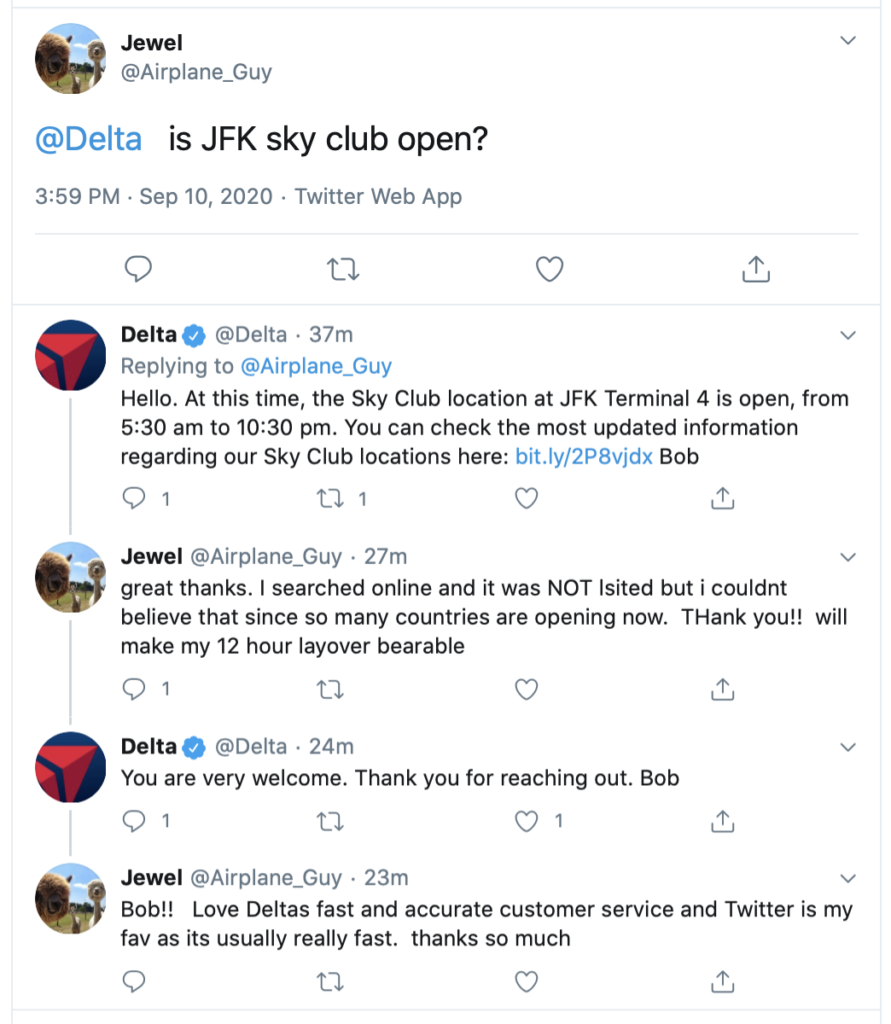
It’s hard to believe that YouTube, Facebook, Twitter, and Instagram were all launched less than 20 years ago. As consumers, we’ve quickly become accustomed to social media being the first place we turn to engage with the brands we love.
Given how embedded social media is within consumers’ day-to-day lives, these channels have also become one of the best ways for brands to reach their audiences. But savvy brands aren’t just using social media to push out content. They’re using it to connect with customers to build, sustain — and sometimes — repair trust. Companies that use social media effectively take a strategic approach, with every choice made laddering up to business objectives and organizational values.
The vast landscape and always-changing nature of social media sometimes makes developing the right strategy overwhelming. Too often, companies fall into the comfortable trap of just using the channels to distribute content. To bring you practical advice you can take back to your team, we interviewed two Authentic Fractional CMOs, Ruth Glaser and Kate Simek, plus two of our trusted Ally Partners, Jennifer Gilhoi, a communication strategist, and Rebecca Gutierrez, a growth marketing leader.
Q1. How and why does the role of social media vary between B2B businesses and B2C companies?
Kate: I’m a big believer in B2H marketing. At the end of the day, as a marketer, you are aiming to capture the attention, heart, and mind of a human. Remembering the human side of a transaction and relationship helps create authentic and effective marketing strategies.
However, how to engage audiences in marketing channels can be very different depending on the transaction. A business buyer typically must make highly informed decisions and must spend time convincing many people and justifying their recommendations. And today, ROI matters more than ever to the business buyer. Consumers are more emotionally driven. They’re growing fiercely educated in their purchase habits and expect personalized, technology-enabled support that anticipates their every desire.
The role of social media must align with the needs of the audience. Far too often, I see businesses on all social media channels because they feel like they “have to be there” to be relevant. The most effective social media strategies focus on the most important channels to your audience and creating a conversation with the human your business is aiming to reach.
Ruth: B2C companies often use social to build brand awareness, drive website traffic and boost sales, while B2B companies tend to focus on brand awareness, relationship-building, influence, and lead generation rather than immediate sales (due to the complexity of the B2B sales cycle). So while these businesses may use some of the same social media channels, their approaches may differ based on their goals and sales cycles.
For B2C, content is heavily visual, and video is by far the best-performing visual content. Instagram’s recent launch of Reels to share 15-second videos, the popularity of TikTok — especially among the coveted Gen-Z and Millennial consumer — and the fact that YouTube is the second-largest internet search engine all attest to the power of video. Compelling video doesn’t need to be highly produced, but it needs to be posted frequently and consistently.
Instagram is the best visual channel and offers impressive audience targeting. And despite continuing data privacy protections and mandates, Facebook remains the best channel to find and target the ideal audience for B2C companies. Other channels, like Pinterest, Twitter, TikTok, etc. may be right for niche audiences.
Because B2B companies use social most often for lead generation, quality content must be the cornerstone of social strategy. White papers, webinars, infographics, demos, and longer videos can be shared on social with options to subscribe or download.
B2B companies typically focus on at most three channels: Twitter, Facebook, and LinkedIn. LinkedIn is too often underutilized. With its discussion groups, Slideshare, Pulse publishing, feed and targeting capabilities, it’s ideal for attracting, engaging and connecting with business audiences.
Q2. What considerations should businesses keep in mind when deciding which employees or resources to task with social media strategy and management?
Rebecca: Prior to assigning resources to manage “social media,” organizations must first understand the ecosystem and how their social media presence will align with their overall business objectives and strategy. Social media platforms are multi-faceted:
- They’re digital marketing platforms that drive customer acquisition and revenue, which require someone experienced and well versed in paid media strategies, optimization, and data-driven performance marketing.
- As the “front door” to many organizations, social channels act as both a corporate press hub and guest service center. This requires a representative of the brand with in-depth knowledge of the organization and its policies who feels comfortable making real-time decisions on behalf of the organization, and who is empowered to do so.
- Social media platforms also play an integral role in any company’s loyalty strategy by providing a way to directly engage with customers in a fun and witty way via their organic social media channels. Creative copywriters or storytellers tend to do quite well in this role.
As you can see, these roles are vastly different — and the talent a company needs to fill these roles will also be quite different in skillsets. In my experience, there are very few people who excel at each element, so I’d recommend prioritizing talent whose expertise best aligns with an organization’s primary business objectives.
Ruth: Rebecca is spot on. Social media strategy and management is a vast ecosystem comprising paid and organic, as well as listening and engagement. And it requires a variety of skill sets.
One smaller B2C brand I’ve worked with manages their social media with this team:
- Marketing leader: strategic planning, oversight and guidance to bring branding and brand voice to life in alignment with business objectives
- External agency: paid digital ad strategy and optimization
- Internal designer/content producer: organic content, creative assets for social ads, and posting. User-generated content curation.
- Internal video content producer (this is rare in my experience)
- Founder: organic content and engagement
- Customer service team: social listening and response to service-related posts
- Community manager: listening, engaging, and facilitating Facebook group
That’s a lot of people with lots of different expertise! But social is the foundation of this company’s marketing strategy, so they put the resources behind it.
Because few small companies can do this, it’s critical to understand how to selectively focus social media efforts to support overall business goals for the best results.
Jen: Social media management is complex and multi-faceted, as Rebecca points out. It is not an afterthought in a marketing strategy, handed over to your social lead when the sales and marketing materials and planning are complete. Companies that prioritize social media leaders early on – who see the unique, specific, and direct connections social media can make to drive business objectives – will be leaps ahead in powerful communication.
I’d love to see businesses think more broadly and creatively about the personality their brand can have via social media. Rather than simply sharing the same content from the website, blog or marketing materials, whose purpose is to inform, promote or communicate in a one-way delivery, social media first and foremost is your way to tell your story in a personal, authentic way that invites two-way conversation. Consider the conversations you want to have and build your social media brand voice and plan per channel around it. It should feel related yet distinctly different from your other channels.
Kate: One of the biggest mistakes I see organizations make is assuming that social media should be done by the youngest person on the team and only by that one person. When looking at how to resource social media within your marketing organization, I would ask the following questions:
- Does your team understand your overall marketing strategy and how social media plays a role?
- Do you have brand guidelines that include brand voice and how your brand shows up (or doesn’t) in each social media channel?
- Do you have goals and KPIs for social media aligned with your overall strategy? How does it/should it drive value to the business?
- How big of a job is social media management for your organization? Are you on all channels? Do you need to answer responses right away? Are you planning to be posting regularly? How are you planning to listen and manage?
After answering these questions, I would first look at internal resources. I usually start by looking for individuals who are comfortable with social media – personally or professionally — and who are curious, proactive, and have an “always on” mentality. There are also great agencies and freelancers (depending on the answer to #4) to help manage, create content, post, listen, and respond.
Q3. How can social media play a role in crisis communication? What are the risks and benefits that brands should consider as they employ social media amid an active crisis or very dynamic situation?
Ruth: Social media’s speed and reach can be a real advantage when it comes to some types of crisis communication, but when done poorly, it can damage brand reputation or even cause a PR crisis.
Social media is the most efficient way to speak to the most people, enabling companies to get ahead of a crisis. Not only can the message be broadcast to a wide audience, but companies can monitor interaction and respond in real-time. It uniquely enables transparency.
To minimize the risk of reputation damage or exacerbating a crisis, it’s important to have a crisis plan before it’s needed. Once a company identifies a crisis, the plan should indicate which social channel(s) will be used and who will create the response, approve the message, monitor engagement, and respond to comments.
Jen: In a crisis, it takes a calm, decisive, thoughtful person who has the trust of the company and confidence in the organization’s crisis communication plan. Public relations professionals are uniquely equipped to address crisis communication and should oversee and direct the social media posts and engagement strategy around the crisis whenever possible.
Due to the public nature of a crisis and the immediate need to respond, Twitter is often the primary channel for communication and where people turn to share their thoughts. Social media’s role in a crisis can be to acknowledge the situation, buy time for the PR team to prepare a more in-depth response, and gather feedback in real-time to get a pulse on the public perception of the crisis.
Crises are inevitably negative, but a company’s quick and thoughtful response and willingness to be vulnerable (as social media demands!) can work in their favor. Also, remember that communication around a crisis often needs to be more in-depth than Twitter allows. Rather than engage with each tweet, address the collective concerns and direct to other assets (e.g., press release, press conference) and be as transparent as possible.
Kate: What have we learned in 2020? Planning for a crisis and being able to adapt quickly is critical. As Ruth noted, social media, due to its speed and reach, is a prime place to communicate during a crisis, and when not done well, it can cause more harm in a difficult situation. Social media must be part of an overall crisis communication plan that includes a multi-channel approach.
Having a crisis communication plan ensures that your organization can respond quickly, transparently, authentically, and empathetically to all audiences. If your organization does not have a crisis communication plan, take the steps to begin creating one today. To help you get started, our friends at Beehive Strategic Communication have created this Crisis Communication Guide.
Social media also provides a way for your organization to listen in a crisis. In order to communicate effectively, you must know your employees’ and customers’ needs. Social media provides a way to listen to those needs and feelings.
The risks and benefits all have to do with trust. Are you able to maintain and strengthen? Or did you erode and weaken? More is being expected of organizations than ever before. They must prioritize people and gain their trust by genuinely caring and helping.
Richard Edelman, CEO of Edelman, which produces the largest global survey on trust said it well:
“At this moment of deepest global crisis, the public wants brands to step up, keep us safe, guide us and help us. Brands that act in the interest of their employees, stakeholders and society at large will reinforce their expertise, leadership and trust and immeasurably strengthen the bond they have with consumers.”
Rebecca: There are several different ways to craft a crisis response based on the situation.
If it’s a situation with a widespread impact, like a cultural movement, never exploit the situation to gain brand awareness, favor, or credibility. Simply acknowledging the situation with a heartfelt, genuine response is a safe approach. Stay away from salesy social media posts within close timing proximity to when you acknowledge the crisis. Mean what you say in your position. For example, if your brand is taking a social stance, articulate how you will follow-through.
If an event happened specifically to/with your brand, first evaluate how egregious the event may have been and whether a response from your team is warranted. If so, post a heartfelt apology across all social media channels and “pin it” for the duration of the crisis (within reason), so it’s easily seen by your community. Don’t engage in ongoing direct communication with followers who are upset, as that tends to add fuel to the flames.
Q4. What specific examples have you seen of companies using social media to authentically build trust and engagement with customers?
Jen: I recently participated in an international group of event and exhibition strategists, where we created case studies of successful authentic engagement in virtual and hybrid events. Without hesitation, this Vikings fan and my partner in the task, a Chargers fan, chose to look at the 2020 NFL Draft. The draft, originally scheduled to occur in Las Vegas from April 23-25, went virtual only one month after the pandemic brought in-person events to a screeching halt.
The draft organizers shifted quickly and delivered a draft viewing experience like no other. Players in their homes with their families streamed their reactions to the picks on social media. The draft created a massive fan-based social media play where each NFL team’s fans shared the screen with the event’s emcee. Additionally, each team tapped into the national event to create their own social media content.
I think this is an especially relevant mention for companies as they should be thoughtfully looking at the continuum of brand engagement from events — whether in-person, virtual or hybrid — to their social media. I believe social media is at its best when used as an invitation to a shared experience. Also noteworthy: the engagement on these types of posts far outweigh informational or promo-driven posts!
Kate: Delta airlines is one of my favorite examples of using social media to engage and build trust – from the early days of social media when being used as a forum for every customer complaint — to the handling of ongoing changes during global pandemic. Delta uses social media as more than a communication platform and even a customer service tool. It uses social media as an extension of its customer experience.
Whether answering a question or concern via Twitter or showcasing health and safety efforts on board their flights, Delta continually builds trust and engagement with customers. It is tempting to use social media like a megaphone, but Delta is a great example of listening to, responding to, and engaging with your audience.




Ruth: Kate commented earlier about the importance of connecting with human beings, no matter the type of business. These days both business buyers and consumers are savvy social media users. We’re all conditioned to quickly tune out posts that focus solely on company and product promotion.
Instead, successful B2B companies connect with people on social media in a way that may seem counter-intuitive: they give away something for free, no strings attached. Often it’s in the form of thought leadership, like a blog or whitepaper. A great LinkedIn example is eCapital Advisors. They’re facilitating a round table for Financial Planning & Analysis Executives about the 2021 budget process. Timely and informative, they’re not selling anyone anything. Rather, they’re positioning themselves as a trusted resource with industry expertise.
B2C companies can use the power of user-generated content (UGC) to connect with their audiences. Customers often see UGC as an indicator of a brand’s quality, over branded content. As an example, Airbnb’s Instagram content is nearly all UGC, which they’ve used to grow their following to over 4.5 million people!
Do you need strategic social media guidance? Our Authentic Fractional CMOs are experienced in helping brands of all sizes use social media to support marketing and business objectives. This experience is always important, but especially in today’s environment as companies navigate disruptive situations and make frequent pivots. Let’s connect to discuss how one of our strategic leaders can help you keep customers engaged and informed on social media and across all marketing channels.










